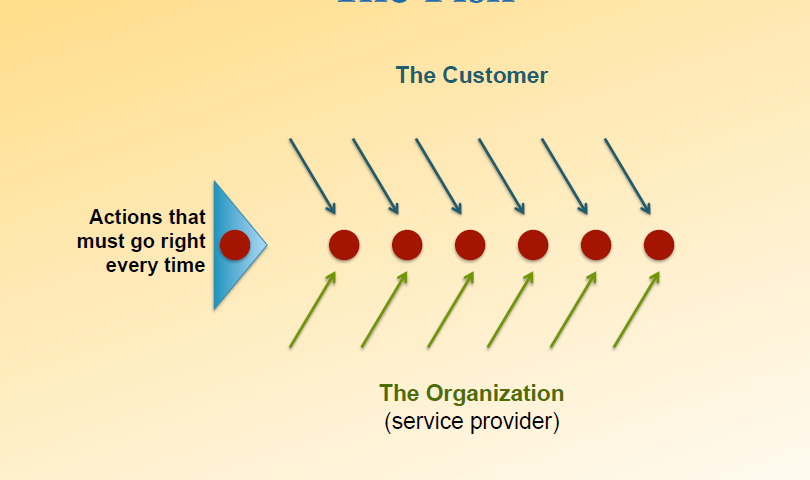
Building Greater Trust for Policing–All about communication
January 14, 2014
Impact of Social Networking on Loyalty
February 11, 2014The Customer Loyalty Experience System
The Customer Loyalty Experience System is a comprehensive approach based on aligning all behavioral aspects of the organization’s culture toward a consistent and engaged Customer Experience by effectively receiving, managing and responding to continuous customer and employee feedback. The quality of the customer experience is vastly improved, the level of employee ownership will be greatly enhanced, customers and employees will have a greater sense of pride in the organization, and the organization will be able to respond and change much faster giving it a significant competitive advantage at surviving and thriving in our current business environment.
How does this System Work?
As with all great systems, they work because they are easy to understand, easy to execute, and it’s easy to determine how they are working or measure the results.
Over the last four years, I have had two experiences that , coupled with my work experience of the 1980’s (Customer Service from the Heart and Teambuilding), help confirm the idea that ,BEHAVIOR DON’T FOLLOW ATTITUDES—ATTITUDES FOLLOW BEHAVIORS – and it’s just not that complicated.
Experience #1
Virginia Mason – Helping to Re-Do a Clinic
I was asked by my personal physician if I would participate in a one-week brainstorm to help totally rework a Virginia Mason Medical Clinic. Because the Kirkland Clinic was moving to a new location, there was a chance to radically reorganize the way the Clinic worked . Virginia Mason has a very large investment in looking at their business (a hospital and 12-15 clinics) through the eyes of ToyotaUniversity – lean, efficient and very user driven.
We started this 1-week brainstorm with an end in mind – greater efficiency for everyone, including the doctors, nurses, specialists, and last (but that is what I was there for) the customer. In the end, it was an amazing week. For 5 days, 25 people – doctors, nurses, clinic manager, architects, everyone in the business – went through this very formal process to:
- Cut the number of steps a doctor and nurse walk by 50%
- Manage the supply of all the medical things needed to do their work with a just-in-time approach
- Let the patients become a bigger part of the system (sort of like pumping gas – would you ever go back to letting someone pump gas into your car)
So there I was, experiencing a discovery process that used the Toyota Production improvement method to re-engineer the entire way a medical clinic operated. The end of this story is that the VM Kirkland Clinic opened in March of 2009, and it is starting to do most everything it set out to do with regard to improving efficienc y. As expected some of the older patients are having some trouble – one of the efforts was to eliminate the clinic waiting rooms – efficiency means no waiting. As the patient representative, I was not old enough – older patients go to their medical clinics weekly and they like to talk to other weekly visitors to the clinic. Oh well, so much for efficiency.
The basic tool to design the space was a concept they called the “Fish”, which really was just a process of engagement about thinking through a transaction and defining all of the stops that the patient needed to do and matching those transaction points with what the clinic employees had to do.
(Insert)
In this diagram, there are two sides – the patient (customer) and the organization. The steps involved for each side are listed to examine efficiencies. For example:
- Patients have to park, so the Clinic had to think about what getting into the parking lot was like, and how big the stalls should be for their patients, and how do older people get out of their car, then get into clinic, etc.
- The next transaction interaction was checking in – what does the patient do and what could be done to ensure when they showed up, this step could be more efficient. When the appointment reminder call was made, what could be done to ensure their visit went well – both efficient and create an outstanding experience.
On and on – every process in the patient’s visit, every process in the clinic business operation went through a “fish” process. Notes were kept, priorities were established, and policies, procedures and behaviors were defined.
Learning #1 – You can look at any operational transaction and create a “fish” approach to understanding what behaviors, policies and procedures must go right every time for the user to have an outstanding experience.
Learning #2 – You can have your employees and customers involved in defining “the fish” and add real insight and valuable consciousness to how things should work more efficiently, and how to create a dynamic and measurable experience for the user.
Learning #3 – This process transfers ownership to the employees – they become vested in not only how it should work, but also as the behaviors become the work standard, the organization has employees that champion the cultural change. Management is listening to the employees and customers before they try to change the culture. Attitude follows ownership of the behaviors.
Experience #2
Tully’s (Where I got to test my long-time belief)
I had been the head of Alumni Relations for the University of Washington for over 5 years and it was a wonderful experience. During the last 1-1/2 years at the UW, I was placed on the Tully’s Board because of my retail background and ultimately left the University to become CEO of Tully’s.
Tully’s is a coffee company that roasts, wholesales, retails in (at the time)over 90 stores in 6 states, and does office coffee through distributors. The company had about 900 employees, most working at the retail stores.
There are lots of learning’s from Tully’s, but this story is about “clarity, alignment, and passion”. How do you change a culture, grow the business, and create a store environment that creates loyal customers? There were many things – almost everything needed to be redone – the stores, the chairs, tables, refrigeration, the employee benefits, the management culture, the products (not the coffee), and most of all – the Customer Service Culture.
As I said in the opening of this section, I have had a frustration about something that I thought was stupid, and it went like this…
We hire people by first writing a job description and then we choose the people to do our job. Once you are hired to do that job, you are then told that you will be reviewed – and in almost every case, the review is different than the job description. So we hired you for one thing and we review you for something else. In the service business, it gets worse – we then have some form of customer/shopper review that, in most cases, is again different from the job description and the performance reviews. So, as a management person, what do you do? Well, the answer is that the whole thing becomes political – one person’s opinion vs. another person’s opinion.
I decided that I wanted to try something I had always thought would work – write the job description so that a manager could review their team on what they were hired for. And then I got lucky!
In walked Max Israel and his product Customerville. Customerville is a 24/7 behavioral feedback system where the customer scores their view of behaviors that must go right every time for the customer experience to be great. Customerville also allows the customer to give comments to the company and, if the comment is bad, it instantly texts messages a management person, and if the comment is very positive, management can print a customer-gram to give to the employee or team of employees.
So here was the perfect integrated system. You write the job description based on behaviors, make those behaviors a central part of the review forms, and let the customers rate those behaviors as well.
What an amazing outcome:
- First – there was clarity. These are the behaviors that must go right every time, and you get continuous feedback on how the team of employees is doing.
- Second – the store was asking for comments and, in today’s world, customers have comments. If it was a bad experience, the manager got to go for an instant recovery, and if it was good, the employee or team receives recognition.
- Third – Politics disappeared. It no longer was just a bunch of discussions about what I thought vs. what you thought. Now it was what the Customer thought.
- Fourth – Teamwork – no longer did the worst performing employee define what would management tolerate. Now the employee team pulled the poor attitudes/performance up or forced them out. It was the store team’s scores, not a manager’s opinion. “Teamwork” comes from team members, it does not come from Management.
Now a thought about receiving Customer Comments.
I can easily tell if an organization really wants to hear from its customers. I just look at how deep into a companies website it is before I find out how to contact the company. As soon as I find the “contact us”, I look at how I get to do this. In most cases, it’s just an email address or they give you a list of all the senior executives. Having access to the senior executives is much better than just an email, but again this means that now the senior executive is the one who gets to hold the power and, in almost all cases, these comments are about something bad.
Just think of the power of using “tell us what you think” or “we would love your feedback” as something that is at the top of the website. It is promoted as a primary message in all of the company’s communication. What if customers actually liked giving you ideas and ways to improve your business. What if your business was driven by customers who “believed” they were part of the team.
This is very powerful stuff. “Word of mouth” is and always has been the best way to grow your business. What better way to get customers involved. The customers become your eyes and help find the best new products, more efficient operation, better policies.



